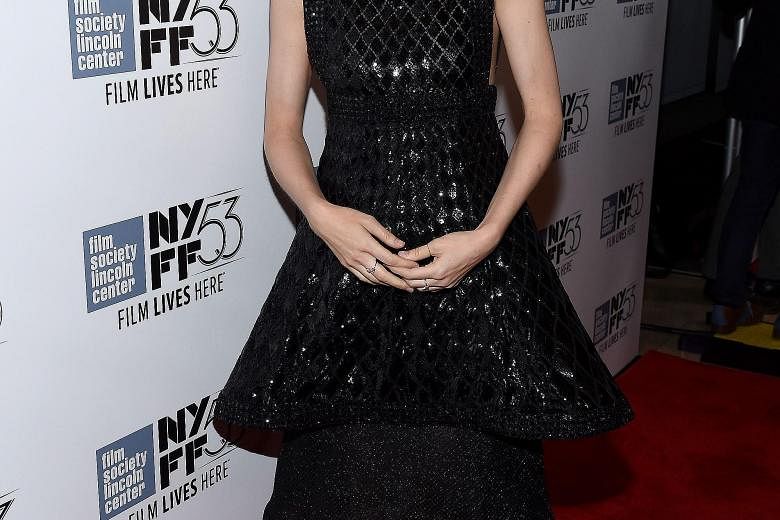NEW YORK • In Carol - set in 1952, the year the American Psychiatric Association proclaimed homosexuality a "sociopathic personality disturbance" - Carol Aird, played by Cate Blanchett, is a glamorous New Jersey suburbanite whose sexual desires are destroying her marriage and jeopardising her motherhood.
But director Todd Haynes' sumptuous lesbian romance, spun from the Patricia Highsmith novel The Price Of Salt, is just as much Rooney Mara's. She plays Therese Belivet, a lonely department store clerk quietly rebelling against the expectations of her inner circle, particularly the boyfriend who wants to marry her.
When Carol forgets her leather gloves on Therese's sales counter, a delicate frisson erupts. It is a manoeuvre both as thrilling as leaving behind a valuable with someone you hope will call again and as dangerous as accepting candy from a stranger.
The hoped-for call comes and eventually the women set off cross- country, running from their obligations and into a forbidden love.
At Cannes, where the film premiered in May, the response was euphoric. Film critic Manohla Dargis wrote in The New York Times that the film was "exquisitely directed and acted". Mara surprised even herself by winning the Best Actress award, which she shared with Emmanuelle Bercot of Mon Roi.
The film took five Golden Globe nods, with Mara and Blanchett up for Best Actress wins.
Mara, 30, was relaxed and playfully candid in a recent interview. To her, Carol is two films: a coming- of-age tale, as both women grow into the next phase of their lives in ways that will allow them to be true to themselves, cushioned in a love story for the ages.
She almost let Carol slip away. Originally offered the role on the heels of The Girl With The Dragon Tattoo (2011), she felt too depleted after a punishing seven-month shoot in Sweden and too raw from being thrust, virtually unprepared, into the media maelstrom.
"All of the sudden, you're a diva or you're difficult or you're a bitch," she said, almost in apology for a reputation that spread early in her career.
"I passed on Carol, which when I think about it now, is insane to me because Cate is one of my favourite actresses," she added.
After completing Steven Soder- bergh's Side Effects (2013), Spike Jonze's Her (2013), David Lowery's Ain't Them Bodies Saints (2013) and a still-untitled Terrence Malick project, then taking a year off, she again received the Carol script, this time with Haynes attached.
Her answer was an immediate yes.
Cincinnati stood in for New York and before shooting began, Haynes sent her a reference book filled with early 1950s photographs by Ruth Orkin, Esther Bubley and Vivian Maier. (In Highsmith's novel, Therese is an aspiring stage designer; Haynes and screenplay writer Phyllis Nagy imagined her as a photographer.)
As for sharing the screen with Blanchett, Mara said: "Obviously, playing a character who is just in awe of her - that part was really easy. To just be watching everything she does and figuring out how you can be that way was pretty much what I was doing anyway. "
Getting naked with her co-star? "Sex is sex, male or female," Mara said. "It's all the same to me."
Perhaps more challenging were the desirous looks filmed immediately after the two actresses met.
"We would be going along and no one would yell 'Cut!' and we'd be looking at the camera" - she struck a pose of intense longing - "and we wouldn't know what to do with ourselves," she recalled. "We were just kind of giggling the whole time."
Then there were Sandy Powell's costumes: for Carol, magnificent furs and form-fitting sheath dresses; for Therese, with her limited income, wool skirts and plaid scarves, still beautiful but more obviously worn.
Eventually, Therese's style comes to echo Carol's, sleek and refined and accessorised perfectly. "I feel like that's how most people come of age," Mara said. "You learn what kind of woman you want to be by looking at other females."
Fashion holds a central role in Mara's life off-screen and her own quest for identity is peppered with sartorial markers:
• The church clothes she wore as a girl in Bedford, New York, to the Sunday football games with her NFL team-founding family - the New York Giants on her father's side, the Pittsburgh Steelers on her mother's. "I was like, this isn't normal."
• The tight jeans and tank-tops she invested in for auditions at the start of her career. "I hated having to go in dressed like a slut to get a part for a job I didn't really want anyway."
• Even the punk uniform, hacked hair, bleached eyebrows and multiple piercings central to Dragon Tattoo. "Being beautiful didn't matter anymore and I felt comfortable for the first time because I had stopped trying to be someone else's idea of what I should look like."
But being beautiful was important as she promoted Carol at the New York Film Festival. A Chanel dress awaited her. "It's a work of art," she said, tracing the hem of its heavy two-tiered skirt and the beading on its latticework bodice.
It also, backlit by the mid-day sun, seemed to portend overexposure. What would she be wearing under it?
Mara levelled her gaze and said: "Nothing."
NEW YORK TIMES

